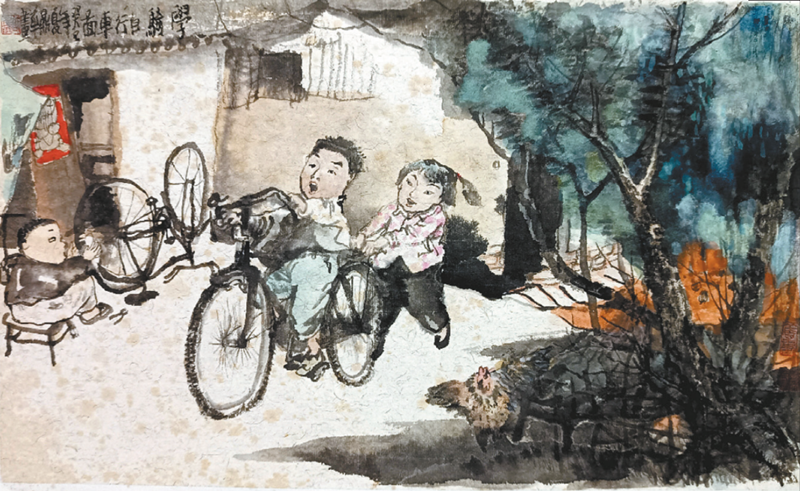Visit “Golden Childhood: Tang Dinghua’s Chinese Painting Exhibition” at Guan Shanyue Art Museum to see playful, tender memories of childhood rendered by Tang Dinghua, professor at the School of Design, Jiangnan University in Wuxi, eastern China’s Jiangsu Province.

A painting by Tang Dinghua depicts children having fun riding a bicycle. Photos courtesy of the artist
The 90 works on display celebrate innocence and human bonds — sibling affection, schoolmate friendships, and grandparent-grandchild ties — conveying the artist’s humane worldview. Most pieces span different periods of Tang’s career, allowing viewers to trace his creative trajectory from steady progress and repeated experimentation to eventual artistic insight.
Tang, an award‑winning picture-book painter in the 1980s, exhibited “Vendors” at the 13th National Art Exhibition and published “A Day in Southern Xinjiang” in Art magazine. The narrative qualities of his picture-book paintings — careful plotting, clear character relationships and strong storytelling — are evident throughout his oeuvre.

Tang Dinghua observes his paintings at the “Golden Childhood” exhibition at Guan Shanyue Art Museum.
For example, in “Listening to Autumn,” several moments — children pausing their homework to listen for a cricket — are juxtaposed to imply temporal progression. Gestures, expressions and props (a cricket basin, a shaded table, toppled bamboo stools) suggest cause and effect and enliven the scene. Through such compositional devices, Tang animates his subjects and invites sustained viewing.
Other works depicting childhood games balance humor and subtlety while conveying enduring warmth and shared nostalgia.
Critics note that technically, Tang favors exaggerated, deliberately distorted figure modeling and rough, expressive line to heighten individuality and emotional tone. His ink handling — subtle control of wet and dry brush, graduated washes and bleeds — creates shifting planes of presence and absence, producing a resonant, semi‑evocative pictorial space. Some critics detect echoes of Huang Binhong and Li Keran in Tang’s paintings, yet his work remains in contemporary ink‑painting discourse.
Tang views painting as spiritual nourishment: the artist savors life’s bittersweetness during creation, while viewers treat paintings as doors into other worlds — sources of joy, consolation or memory.
Tang graduated from the China Academy of Art in eastern China’s Zhejiang Province in 1982. He is a member of the China Artists Association and a postgraduate supervisor at Jiangnan University’s School of Design. He also serves as a researcher at the Jiangsu Provincial Federation of Literary and Art Circles’ Calligraphy and Painting Research Center, an artist at the Wu Guanzhong Art Museum, and a researcher at Jiangnan University’s Institute of Calligraphy and Painting.
Dates: Through Oct. 12
Hours: 10 a.m.-5 p.m., closed Mondays (Open until 9 p.m. on Fridays and Saturdays)
Venue: Guan Shanyue Art Museum, Futian District (关山月美术馆)
Metro: Line 3 or 4 to Children’s Palace Station (少年宫站), Exit F2